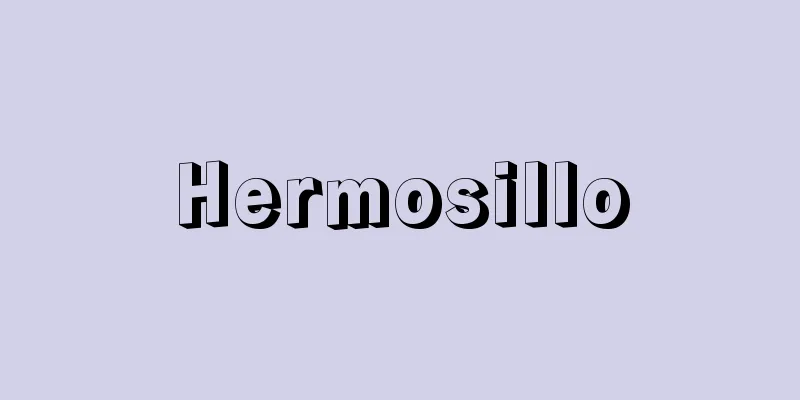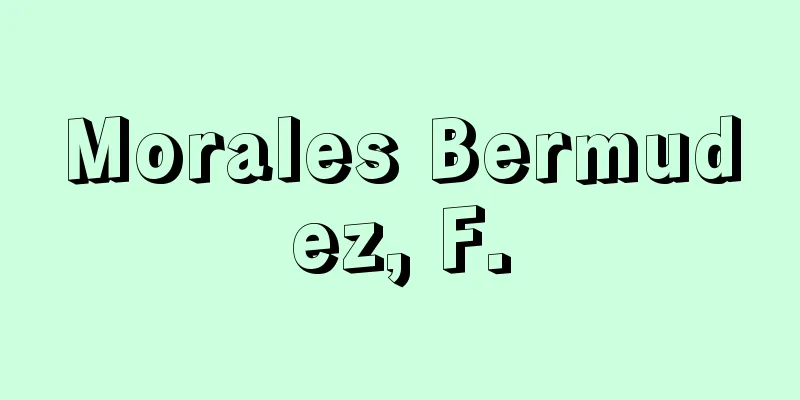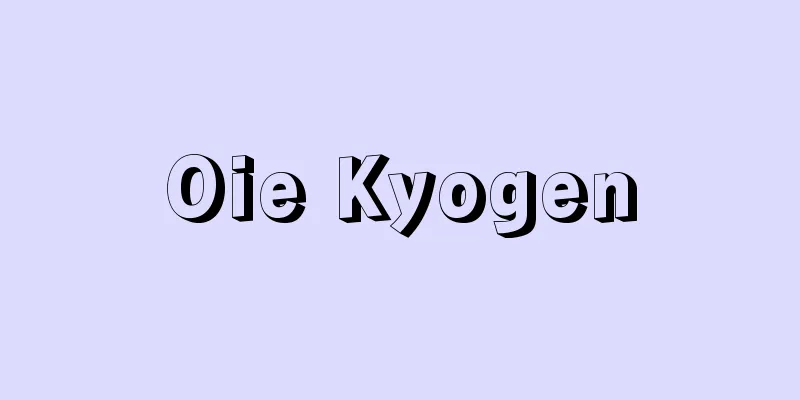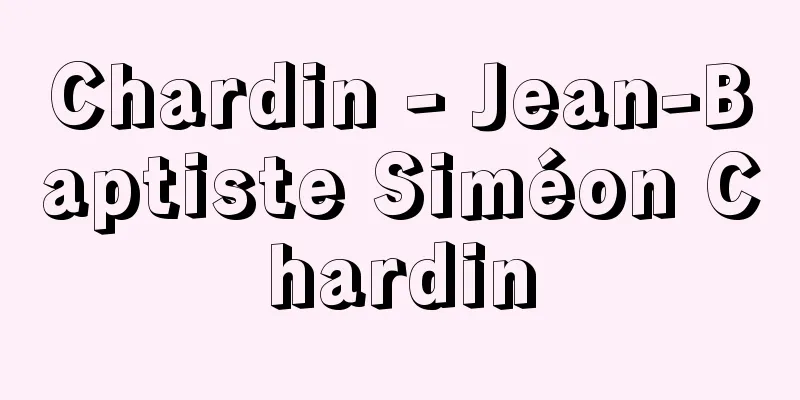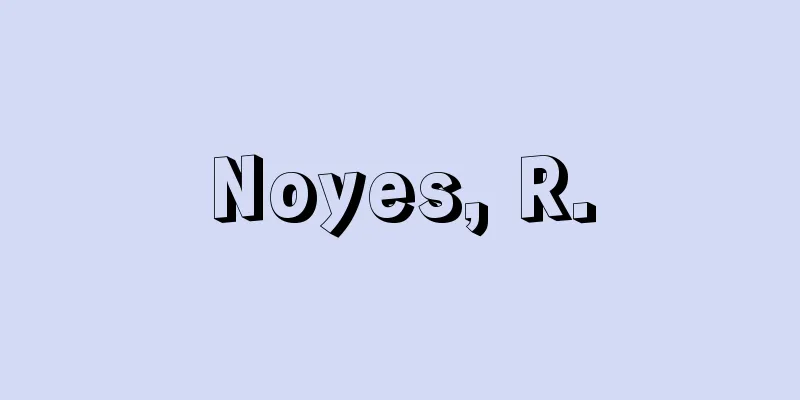Primitive society
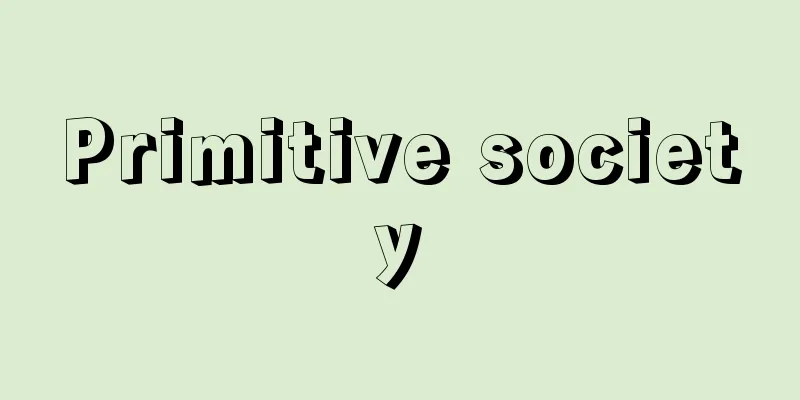
|
A society that is considered to be in an underdeveloped, undifferentiated stage of human culture. In historical terms, it refers to past societies that existed before the development of urban civilization, and is also called a primitive society. Societies that exist today outside of civilization are also called primitive societies. This article will focus on the latter meaning of primitive societies. For historical ones, please refer to the entry for "primitive society". However, there are problems with this simple definition, which will be explained in detail in the following sections. [Yasushi Kato] What is primitive and what is a primitive society?Primitive peoples and societies are one of the problems that have intrigued the Western world for centuries. There has been and still is much intellectual activity surrounding this subject. The field, established in the 19th century, is now called cultural anthropology, social anthropology, or simply anthropology (from this point on, we will use the term anthropology). For a long time, the West has been asking what a savage person is and what the relationship is between savage societies and "our" society, the West. In the process, the idea that anthropology studies savage people and societies was formed. Today, anthropology has accumulated a vast amount of knowledge about savage societies, and we can learn about a savage society as if it were our neighbor. Moreover, the more savage the society, the more anthropologists want to know. If anthropology is the study of primitive societies, what kind of societies do anthropologists actually study? For example, let us take two well-known books with the word primitive in their titles, Structure and Function in Primitive Societies (1952) by Radcliffe Brown and Social Organization in Primitive Societies (1962) and randomly select the societies mentioned in them. These include the Ashanti, Nuer, and San of Africa, the Andaman Islanders of the Indian Ocean, the Nayars of China and India, the Semang of the Malay Peninsula, the Aborigines of Australia, the Minangkabau of Indonesia, Japan, the Trobriand Islanders of Oceania, Hawaii, American Indians, Incas, Eskimos, and ancient Romans. What do these societies have in common? What criteria do anthropologists use to call these societies primitive? Of course, the answer can be found in the above books, which are labeled as studies of primitive societies. However, there is no definition of primitive societies, nor any reason why they should be distinguished from other societies and lumped together. For example, the introduction to Radcliffe Brown's book includes the phrase "anthropology means the study of so-called primitive or backward peoples." This alone explains both anthropology and primitive societies. This is not a flaw found only in these works. On the one hand, there is the conventional wisdom that anthropologists study primitive societies. On the other hand, the societies that anthropologists have actually studied are dozens of times more diverse than the list above. The proposition that anthropologists study primitive societies, and the question of what a primitive society is, are no longer self-evident. Despite this, many anthropologists have not tried to change their view that they know very well what primitive societies are, and that the study of such societies is the study of anthropology. However, this situation has been noticed by many anthropologists. For example, Sol Tax lists the societies that anthropologists use under the term "primitive" and notes that it seems to mean only the societies "that anthropologists study." He then questions why "primitive." He believes that the term "primitive," which is used to encompass the various societies that anthropologists study, does not have a proper concept. He says that it is merely a term of convenience adopted by some in the West to lump together all the rest of the world's people, past and present. Up until now, anthropologists have worked with the term primitive society, naively believing that it has some substance, but that substance has never been clearly defined or sharply outlined. It has been used by anthropologists in a wide variety of ways; Lois Mednick, a research assistant to Tax, counted as many as 23 different meanings of the term primitive. So, first, let us consider the concept of "savage" from the standpoint of grasping primitive societies as entities and clarifying the essence of those entities. Next, we need to briefly consider not only the semantics of the concept of "savage" but also its historical usage. How did the West create the concept of "savage" and what position has it been given? Finally, let us consider how we can use the concept of "savage". [Yasushi Kato] Primitive society as an entityAnthropologists have long held the rarely reflected belief that primitive societies must have some common substance. At the same time, however, it is also widely accepted that the term "primitive" itself is inappropriate, since it seems to be easily linked to the evolutionary prejudice that societies evolve and are thus differentiated into inferior primitive societies that have not yet evolved and superior civilized societies. Thus, attempts have been made to clarify the essential characteristics of certain entities designated by the term "primitive" and to replace them with the term "primitive." Representative examples include "traditional society," "pre-civilized society," "simple society," "tribal society," "pre-literate society," and "cold society." These paraphrases are attempts to answer the question of what a primitive society actually is , so let us explain each of them. [Yasushi Kato] Traditional SocietyThis is a way of thinking that regards primitive societies as societies that basically do not change. Originally, "traditional" meant something that has been passed down unchanged since ancient times, but it has come to be used to describe non-Western societies and cultures that have not been influenced by Western society and culture, or that existed before they were influenced by Western society and culture. This term is frequently used in the titles of research papers, such as "Traditional Social Organization in Africa" and "Traditional Art of a XX Tribe." When we look at how the word "traditional" is used, we can see that it is based on a dualistic way of thinking, such as "Western = modern = change/development = historical" and "non-Western = traditional = stagnation/fixed = non-historical." However, even if something is traditional, it cannot be thought of as completely "unchanged" or "without history." For example, Franz Boas sees the concept of tradition in a more positive light, rather than as something lacking the characteristics that make Western Europe look Western. He believes that even primitive societies naturally have long histories, but that they have customs and practices that resist the changes that occur in that process. In other words, "the more primitive a society is, the greater the number of constraints that determine all actions." [Yasushi Kato] Pre-(Un)civilized SocietyThis is a variation of the thinking that attaches a negative symbol to the Western characteristics of "uncivilized" or "precivilized." Therefore, the requirements for civilization must first be clarified. Robert Redfield is an anthropologist who tried to clarify the characteristics of primitive societies by contrasting them with civilized societies. He provides a relatively comprehensive analysis in The Transformation of the Savage World (1953). Following Childe, he states that civilization emerged with the establishment of cities, and that at the same time, states, public works, markets, documents, etc. were created. In contrast, he sees primitive societies as small-scale, isolated, homogeneous, self-sufficient, and without writing. Redfield discusses how such primitive societies transform into civilized societies. These characteristics of primitive societies are the common belief held by many modern anthropologists, and similar ideas are written in many textbooks. [Yasushi Kato] Simple SocietyOne of the widely accepted beliefs about primitive societies is that modern societies are complex, but primitive societies are simple. However, what is simple is not as simple as it seems. The second definition of primitive societies that appears in Radcliffe Brown's book mentioned above is "simple society." However, this is also more of a paraphrase than a definition, and what is simple is treated as if it is self-evident. It seems to say that a society is "simple" when the number of elements is small and the relationships between the elements are clear when the society is broken down into its components. As a special example, the lack of development of division of labor is often cited as a characteristic of primitive societies. Of course, it can be said that there is no society in which division of labor does not exist at all. In particular, division of labor between men and women and division of labor based on age can be found in all primitive societies. However, the division of labor in such primitive societies has the following characteristics. According to Toshiharu Abe, "Experts in any field live in the same place as other people, meet each other every day, share their occupations, and share activities and experiences in the places where they perform various social functions." [Yasushi Kato] Tribal SocietyThe most common name used to refer to individual primitive peoples is "something tribe." In this case, "tribe" means tribe. The word tribe is often used with a vague image of a society lacking the clear institutions that make up a civilized society. There is no common understanding of what a tribe is. Marshall Sahlins uses the term tribes instead of primitive people, which he says refers to "a group of people with a common origin and customs, who own and control their own territory." Furthermore, tribes are distinguished from citizens of modern nations by their social structural characteristics, that is, segmentation. Segmentation means the following: In tribal society, families are subsumed into territorial lineages, which are subsumed into village communities, which are subsumed into regional associations, and these regional associations constitute tribes. In this way, tribes appear as pyramids of social groups, or hierarchies of segmentation. [Yasushi Kato] A society without writingThe term non-literate society has come to be used in place of traditional society or tribal society. George Homans, for example, argues that the term savage is inappropriate, and that "non-literate" peoples would be a better choice. However, the lack of writing does not imply anything about the structure of the society itself. Homans believes that these societies share other common characteristics of social organization. That is, according to Homans, "More activities in these societies than in any modern Western society are carried out through organizations whose membership is determined by kinship principles." However, this does not make it clear whether it is the lack of writing that distinguishes primitive societies from other societies, or rather the important role played by kinship in the social structure (or both). Jack Goody believes that human societies cannot be divided into two groups, regardless of the indicators we choose that relate to the very structure of society, but he finds special significance in the lack of writing, because he believes that the presence or absence of a writing system creates a decisive difference in communication patterns. In Barbarism and Civilization, Goody examines the significance of writing for the systems related to knowledge, cognition, and thought in human society, and argues that what has been called the "irrationality" and "pre-logic" that are considered to be the characteristics of primitive societies are not related to the "mentality of the barbarian" but to the communication system. [Yasushi Kato] Cold societyThis is a concept proposed by Lévi-Strauss, who rejects the notion of primitive and civilized societies in terms of the relationship between the stages of human history. According to him, a cold society is one whose internal structure is regular and harmonious, and in which events are constantly absorbed into its structure. Its history is therefore repetitive, and change is kept to a minimum. Its opposite concept is the "hot society," in which events constantly change the structure, and a cumulative history emerges. If this concept is related to the formation of society, then it also formulates the corresponding mode of thinking, according to Lévi-Strauss. This is concrete, magical, and mythical thinking, which he calls "wild thinking" in contrast to the "tamed thinking" of a hot society. [Yasushi Kato] Historical Understanding of Barbarian ConceptsPrimitive society is a translation of primitive society. This term can also be translated as primitive society. In other words, primitive society not only refers to non-Western societies, but also means the "first" or "beginning" society in terms of time. The origin of the word primitive is the Latin word primitivus, which means "the first born." However, non-Western societies have not always been associated with "first born" societies. In other words, the word primitive has not always been used in the sense of uncivilized. Every ethnic group has a framework for understanding people other than their own. For example, it is well known that the Greeks called such others barbarians (those who speak an incomprehensible language). It is not clear whether strangers from other ethnic groups or living on remote islands are "human" in the first place, and rather, the concept of man originally refers to one's own ethnic group. The other who cannot be subsumed within the concept of man will inevitably take on a monstrous quality. In medieval Europe, this monstrous other appears as a "wild man" or "savage" who lives in the forest. Both wild and savage originally mean "forest." This idea of a savage is linked to the inhabitants of non-Western societies who came into the field of vision of Western Europe as it entered the Age of Discovery in the 15th and 16th centuries and expanded its spatial awareness. Even if these inhabitants "discovered" by the West had somehow managed to escape from being "dog-headed men," "tailed men," "women-folk," or "cannibals," they were inferior to Western Europeans, that is, "not fully human," because they "wore the skins of wild beasts, ate raw meat, and spoke an incomprehensible language," and because they were "black with sooty skin, had black hair, spoke a language, but had no religion." In fact, the question of whether American Indians were human or not was officially discussed at the University of Salamanca in Spain in 1550-51. Foreign peoples, that is, the inhabitants of the "outside of our world" = "other world," were positioned in time in relation to Christianity on the one hand, and to Enlightenment philosophy on the other. However, that time came to take on two opposing characteristics. One is a time that becomes higher and better the further it goes, and the other is a time that is perfect at the beginning and becomes more corrupt the further it goes. The former is a progressive sense of time that was established as evolutionism in the 19th century, while the latter is a regressive sense of time that is typically seen in Rousseau. Although the remnants of Rousseau's "noble savage" can be found in our current view of primitive societies, the idea of progressive time consciousness, or social progress, has a much stronger influence. Thus, the "savage" of the "other world" became the savage as a remnant of "what came before." In other words, the savage is both the other and the ancestor. This idea of viewing primitive societies as remnants of the original form of humanity from which Western Europe departed long ago was established in the 19th century during the process of the establishment of the academic discipline of anthropology. The most widely influential of these so-called evolutionary anthropologists was Lewis Morgan, who saw all human history as a linear process passing through three stages: "barbarism," "ignorance," and "civilization." Although this stage theory is no longer persuasive in anthropology, the societies that Morgan labeled as barbaric or ignorant, and even among the civilized societies that were not well known in the West, have still been lumped together and called primitive. [Yasushi Kato] Savage and CivilizedSo far, we have looked at the following problems inherent in the concept of a primitive society: [1] The concept of a primitive society is vague and ambiguous. [2] From among the various meanings, one or more meanings are often extracted to represent the essence of primitive societies and used interchangeably with other terms. [3] Despite its ambiguity, the term primitive society is still used because of the place it has occupied in the history of ideas. Taking these things into account, what attitude can we take toward the term "primitive society"? If we do not take the position of trying to find the essence of primitive society, there seem to be two possibilities. Edmund Leach examines three characteristics that have been thought to be characteristic of primitive societies: "homogeneity," "segmentation," and "mythology," and argues that these cannot be accepted uncritically, and that even if such characteristics are found, they do not distinguish civilized societies from primitive societies. In his opinion, some primitive societies fit this model very well, but others do not. Therefore, between civilized and primitive societies, "there is no meaningful discontinuity, either in structure or form. The social anthropologist can find what he is looking for in either society." Leach's position is that not only does the entity called a primitive society not exist, but that there is no merit in adopting a binary model of civilization and primitive, regardless of what concept is given to it. However, there are also positions that seek to find positive significance in using the conceptual model of civilization and primitive. For example, Toshiharu Abe models a primitive society as follows: "A primitive society is one in which a relatively small group maintains relative self-sufficiency, autonomy, and completeness in social functions such as economy, politics, and culture." In such a society, the division of labor and the relationship of rulers and ruled are not well developed, and the number of components is small and the relationships are simple. Although these characteristics are continuous and relative when viewed individually, they can provide a framework for understanding the diverse societies of humankind when paired with the similarly constructed civilization model. We can find civilization and primitiveness in all societies. There will be much debate in the future about what kind of understanding and attitude is possible regarding the concept of primitive societies, but this issue is deeply related to the nature of the academic field of anthropology. We must not forget that we have not been trying to understand primitive societies, but rather to understand others. This otherness has historically been linked to primitiveness, but when others exist and differences appear, understanding is required. Anthropology is the field that responds to this. [Yasushi Kato] "Savageness and Civilization" by Abe Toshiharu (included in "Contemporary Cultural Anthropology" edited by Ishikawa Eikichi, 1978, Kobundo)" ▽ "Conversations with Lévi-Strauss" by Georges Charbonnier, translated by Tada Tomiko (1970, Misuzu Shobo)" ▽ "Savageness and Civilization" by Jack Goody, translated by Yoshida Teigo (1986, Iwanami Shoten)" ▽ "A Guide to Social Anthropology" by Edmund Leach, translated by Nagashima Nobuhiro (1985, Iwanami Shoten)" ▽ "Rethinking Anthropology" by Edmund Leach, translated by Aoki Tamotsu and Inoue Kaneyuki (1990, Shisosha)" ▽ "Savage Social Organization" by Herman Service, translated by Matsuzono Makio (1979, Kobundo)" ▽ "Tribal Peoples" by Marshall Sahlins, translated by Aoki Tamotsu (1972, Kashima Publishing Co.)" ▽ "Structure and Function in Primitive Societies" by Radcliffe Brown, translated by Aoyagi Machiko (1975, Shinsensha)" ▽ "The Transformation of the Primitive World" by Robert Redfield, translated by Someya Omimichi and Miyagi Masaru (1978, Misuzu Shobo) ▽ "Reexamining the Concept of 'Primitive' I, II" edited by Kawada Junzo (1989, 1991, Libroport)" ▽ "Franz Boas Race, Language, and Culture (1888, Macmillan, New York)" ▽ "George Homans The Human Group (1950, Macmillan, New York)" ▽ "Sol Tax & Lois Mednek "Primitive" peoples (1960, Current Anthropology, Vol. 1)" [Reference items] | | |Source: Shogakukan Encyclopedia Nipponica About Encyclopedia Nipponica Information | Legend |
|
人類文化の未発達、未分化の段階にあるとされる社会。歴史的なものとしては、都市文明発達以前の過去の社会をさし、原始社会ともよばれる。また現在も文明の外にある社会も未開社会とよばれる。本項では後者の意味の未開社会を中心に説明する。歴史的なものは「原始社会」の項を参照されたい。ただし、このような単純な定義では問題があり、次節以降で詳説する。 [加藤 泰] 未開とは、未開社会とは何か未開人および未開社会は、ここ数世紀にわたって西欧を刺激し続けてきた問題の一つである。この問題をめぐって多くの知的営為が行われてきたし、いまなお続けられている。19世紀に確立されたこの学問分野は、現在、文化人類学とか社会人類学あるいは単に人類学とよばれている(以後は人類学という名称を用いる)。 西欧は長い間、未開人とは何なのか、未開社会と「われわれ」の社会=西欧の関係はどんなものなのかと問い続けてきた。その過程で、人類学はもっぱら未開人や未開社会を対象として研究するという通念ができあがった。現在、人類学が蓄えた未開社会に関する知識は膨大なものであり、われわれはある未開社会について、われわれの隣人のように知ることができる。そのうえ、その社会が未開であればあるほど、人類学者の知識欲も増大するという現象も存在する。 未開社会を研究対象とするのが人類学であるとするなら、人類学者は実際にどんな社会を研究しているのだろうか。たとえば、タイトルに未開の語を用いているよく知られた著作のなかから、ラドクリフ・ブラウン著『未開社会における構造と機能』(1952)とエルマン・サービス著『未開の社会組織』(1962)の2冊を用いて、そのなかで触れられている社会をアトランダムに拾ってみよう。アフリカのアシャンティ、ヌエル、サン、インド洋のアンダマン島民、中国、インドのナヤール、マレー半島のセマン、オーストラリア先住民、インドネシアのミナンカバウ、日本、オセアニアのトロブリアンド島民、ハワイ、アメリカ・インディアン、インカ、エスキモー、古代ローマ等々である。これらの社会に共通のものは何だろうか。人類学者はどのような規準を用いてこうした社会を未開とよぶのだろうか。もちろん、上記の本は未開社会の研究と銘打っているのだから、答えはそこにみつかるはずである。ところが、そこに、未開社会の定義も、どのような点でこれらの社会が他の社会から区別され、ひとかたまりのものとされねばならないかの理由もみいだすことはできない。たとえばラドクリフ・ブラウンの本の序論には、「いわゆる未開なあるいは後進的な民族の研究を意味している人類学」という一節がある。これだけで人類学と未開社会の両方が説明されてしまう。 これはこれらの著作にだけみられる欠陥ではない。一方には、人類学者は未開社会を研究するという定説がある。他方、実際に人類学者が研究対象としてきた社会は上記のリストの何十倍も多様である。もはや、人類学者は未開社会を研究するという命題も、未開社会とは何かという問題も自明のものとはいえないのである。それにもかかわらず人類学者の多くが、未開社会が何であるかはよく知っていることであり、その未開社会を研究するのが人類学なのだという考えを変えようとはしなかった。 しかし、こうした状況はかなりの人類学者によって気づかれてはいる。たとえば、ソル・タックスは、人類学者が未開という語のもとにあげる社会を数え上げ、結局それは「人類学者が研究する」社会のことを意味しているにすぎないように思われると述べている。そして彼は、なぜ未開なのか、と疑問を呈する。彼は、人類学者の研究対象となるさまざまな社会を包括するために用いている未開という語は、まともな概念をもっていないと考える。それは、単に西欧の一部が、過去も現在も含めて世界の残りの人々すべてを一からげにするために採用した便宜的な用語にすぎないのだという。 これまで人類学者は、未開社会ということばにはなにか実質があると素朴に信じて研究してきた。しかし、その実質は明晰(めいせき)に定義されはっきりした輪郭を与えられていたわけではない。人類学者によって実に多様な意味で用いられている。タックスの研究助手ロイス・メドニックが数え上げたところでは、未開という語は23もの違った意味で用いられているという。 そこで、まず未開社会を実体としてとらえ、その実体の本質を明らかにしようという立場から未開の概念を検討してみよう。次に、未開の概念の意味論だけではなく、その歴史的用法をも簡単に考慮しておく必要があるだろう。西欧はどのようにして未開という概念を生み出し、それにどのような位置を与えてきたのかということである。そして最後に、われわれは未開概念をどのように用いることができるかを考えてみたい。 [加藤 泰] 実体としての未開社会人類学者は、未開社会にはなんらかの共通の実質があるに違いないという、あまり反省を向けられることのない信念をもち続けてきた。しかし同時に、未開ということばそのものは不適切だという考えもまたかなり受け入れられている。というのは、このことばは、進化主義的な偏見、つまり社会は進化するものであり、その結果まだ進化していない劣った未開社会と進化し優れた文明社会とに分化している、という考えと容易に結び付くように思われるからである。そこで、未開社会という用語で指示されるある実体がもっている本質的特徴を明らかにし、それを未開という語にかえようとしてきた。その代表的なものをあげれば、「伝統的社会」「前(非)文明社会」「単純社会」「部族社会」「無(先)文字社会」「冷たい社会」などである。こうした言い換えは、そのまま未開社会とは実は何かという解答の試みになっているので、それぞれについて説明してみよう。 [加藤 泰] 伝統的社会未開社会を基本的には変化のない社会ととらえる考え方である。伝統的とは本来、昔から変わらずに伝えられてきたものをさすが、それが西欧の社会と文化の影響を受けていない、あるいは受ける以前の非西欧社会と文化に用いられるようになったのである。この用語は「アフリカの伝統的社会組織」「○○族の伝統的美術」などと論文のタイトルに頻繁に使われる。伝統的という語の使われ方をみれば、そこに「西欧=近代的=変化・発展的=歴史的」「非西欧=伝統的=停滞・固定的=非歴史的」という二元論的思考が前提とされていることがわかる。 しかし、伝統的といっても完全に「変化のない」「歴史のない」と考えることはできないだろう。そこで、たとえばフランツ・ボアズは伝統的という概念を、西欧を西欧らしくみせている特徴を欠く、としてではなく、より肯定的にとらえている。彼は、未開社会にも当然長い歴史があるが、その過程で生じる変化に抵抗する慣習性や風習をもっていると考えるのである。いいかえるなら、社会が「未開であればあるほど、すべての行為を決定する制約の数が増えるのだ」という。 [加藤 泰] 前(非)文明社会「文明のない」あるいは「文明以前」という西欧の特徴に負の記号をつける思考のバリエーションである。したがってまず文明の要件が明らかにされねばならない。文明社会との対照によって未開社会の特質を明らかにしようとした人類学者にロバート・レッドフィールドがいる。彼は『未開世界の変貌(へんぼう)』(1953)のなかで比較的まとまった考察を行っている。彼はチャイルドに倣い、文明を都市が成立したことによって出現したものとし、それと同時に国家、公共事業、市場、文書などが生み出されたと述べる。それに対して、未開社会は小規模で孤立し、同質的で自足的であり文字をもたないととらえる。レッドフィールドはこのような未開社会がどのように文明社会へと変貌していくのか論じている。未開社会についてのこれらの特徴は現代のかなりの人類学者が共通に抱いている通説であり、多くの教科書にもこれに類したことが書かれている。 [加藤 泰] 単純社会未開社会について広く受け入れられている信念の一つが、近代社会は複雑であるが未開社会は単純だ、というものである。しかし、何が単純なのかは見かけほど単純ではない。ラドクリフ・ブラウンの前掲書に現れる未開社会の二つ目の定義が「単純社会」である。しかし、これもまた定義というよりはむしろ単なる言い換えで、何が単純かということは自明であるかのように扱われている。社会を構成要素に分解したとき、その要素の数が少なく要素間の関係がはっきりしているとき、その社会が「単純」だといっているようである。その特殊な例として、分業が発達していないということは未開社会の特質としてしばしばあげられる。もちろん分業がまったく存在しない社会はないといってよい。とくに男女の分業および年齢に基づく分業はすべての未開社会にもみられる。しかし、こうした未開社会における分業は次のような性質を帯びている。阿部年晴(としはる)によれば「いずれの分野の専門家も、他の人々と同じ場所に住んで日々顔を合わせ、生業をともにし、さまざまな社会的機能を遂行する場で活動と経験をともにしているのである」。 [加藤 泰] 部族社会個々の未開民族を呼び表すためにもっとも頻繁に用いられているのが「○○族」という名称である。この「族」は部族を意味している。部族という語も、文明社会を構成する明確な制度を欠いた社会、というような漠然としたイメージで用いられることが多い。部族とは何かについての共通の理解が存在しているわけではない。マーシャル・サーリンズは未開民族のかわりに部族民という用語を用いているが、それは「共通の起源と慣習をもち独自の領土の所有と支配を行う一群の人々」をさすという。さらに部族は、社会構成上の特性、つまり分節性によって近代国家の国民とは区別される。分節性とは次のような事柄を意味している。部族社会の家族は地縁的リネージ(系族)に、リネージは村落共同体に、村落は地域連合体にと次々に包接され、地域連合体が部族を構成するのである。こうして部族は社会集団のピラミッド、あるいは分節のヒエラルヒーとして現れるという。 [加藤 泰] 無(先)文字社会伝統的社会や部族社会にかわってよく用いられるようになったのが無文字社会ということばである。たとえばジョージ・ホマンズは、未開民族ということばは不適切であり、「無文字(読み書きをしない)」民族とよぶほうがよいと主張する。しかし、文字がないということは社会の成り立ちそのものについてなにかを意味するわけではない。そこでホマンズはこうした社会には、ほかの共通の社会組織に関する特徴が存在すると考える。つまり、ホマンズによれば「これらの社会では現代のいかなる西欧社会にも比して、多くの活動が親族の原理によって成員権が決められる組織によって遂行されるのである」という。 しかし、これでは、未開社会が他の社会から区別されるのが、文字をもたないことによるのか、あるいはむしろ親族組織が社会構造のなかで大きな位置を占めることによるのか(それともその両方によるのか)よくわからない。ジャック・グディは、社会の成り立ちそのものにかかわるどのような指標を選ぼうと、人類の社会を二群に分けることはできないと考えるが、文字をもたないということに特別の意義をみいだしている。というのは、書字法をもつかもたないかということはコミュニケーション様式の決定的な違いを生み出すと考えるからである。グディは『未開と文明』のなかで、人間社会の知識や認識や思考にかかわる制度にとって書字法がどのような意義をもつか検討し、未開社会の特質とされる「非合理性」とか「前論理」とかいわれてきたものが、「未開人の心性」にではなくコミュニケーション体系に関与していると論じている。 [加藤 泰] 冷たい社会これは、未開社会と文明社会を人類史の発展段階の先後関係においてとらえることを拒絶するレビ(レヴィ)・ストロースによって提出された概念である。彼によれば、冷たい社会とは内的構成が規則的で調和的であり、できごとが構造の内に絶えず吸収されるような社会である。したがってその歴史は反復的であり、変化は最小にとどめられる。その対概念が「熱い社会」で、そこではできごとがつねに構造を変えてゆき、累積的な歴史が現れるのである。この概念が社会の成り立ちにかかわるとすれば、それに対応する思考様式をも定式化している、とレビ・ストロースはいう。それは具体的、呪術(じゅじゅつ)的、神話的思考で、熱い社会の「飼いならされた思考」に対して「野生の思考」とよばれる。 [加藤 泰] 未開概念の歴史的理解未開社会はprimitive societyの翻訳である。このことばは原始社会とも訳される。つまり、primitive societyは非西欧社会をさすだけではなく、時間的に「最初の」「始まりの」社会をも意味している。primitiveの語源はラテン語のprimitivusで「先に生まれたもの」を表している。しかし、非西欧社会がつねに「先に生まれた」社会と結び付けられていたわけではない。いいかえれば、primitiveという語は、つねに未開という意味で用いられてきたのではない。 どのような民族であれ、自民族以外の人々を位置づける理解の枠組みをもっており、たとえばギリシア人はそうした他者をバルバロイ(わけのわからないことばを話す者)とよんでいたことはよく知られている。異民族や辺境に住む見知らぬ人々がそもそも「人間」であるかは明らかではないし、むしろ人間の概念が本来自民族をさすものなのである。人間の概念に包摂されない他者は必然的に怪物性を帯びることになろう。中世ヨーロッパではこの怪物性を帯びた他者が、森に住む「野生人」「野蛮人」wild man, savageとして現れる。wildもsavageも本来は「森」を意味する語である。この野蛮人の観念が、15~16世紀大航海時代に入り空間的認識を拡大した西欧の視野に入ってきた非西欧社会の住民たちと結び付けられるのである。 これら西欧によって「発見」された住民たちが、「犬の頭をもった人間」とか「しっぽのある人間」「女人族」とか「食人種」であることをどうにか脱したとしても、「野獣の皮をまとい、生肉を食らい、わけのわからぬ言語を話す」ことや、「色は煤(すす)けて黒っぽく、髪は黒く、ことばは話すが、宗教はもたない」ことにより、彼らは西欧人より劣った、つまり「完全な人間ではない」存在だった。実際、アメリカ・インディアンが人間か人間でないかという問題が1550~51年スペインのサラマンカ大学で公式に論じられたという。 異民族、つまり「われわれの世界の外部」=「異界」の住民は、一方でキリスト教との関連で、他方では啓蒙(けいもう)主義哲学との関連で時間のなかに位置づけられた。しかし、その時間は二つの相反する性質を帯びることになった。一つは先に進めば進むほど高く優れたものになる時間であり、もう一つは始まりこそが完全で、先に進めば進むほど堕落していくような時間である。前者は19世紀に進化主義として確立される進歩的時間意識であり、後者はルソーに典型的にみられるような退歩的時間意識である。 ルソーの「高貴な野蛮人」の残像は、現在のわれわれの未開社会観にも認められないわけではないが、はるかに強力に作用しているのが進歩的時間意識、あるいは社会進歩の観念である。こうして、「異界」の「野蛮人」は「先に生まれたもの」の残存としての未開人になったのである。つまり未開人は他者であると同時に祖先でもあることになる。このような、未開社会をもって西欧もまたはるか昔にそこから出発してきた人類の始原の姿の名残(なごり)とみなす考えは、19世紀に人類学という学問が成立する過程で確立された。 このいわゆる進化主義的人類学のなかでもっとも広範な影響を及ぼしたのはルイス・モルガンであるが、彼は全人類史を「野蛮」「蒙昧(もうまい)」「文明」の三段階を経る直線的過程と考えた。人類学ではこの段階説はもはや説得力をもたないが、モルガンが野蛮や蒙昧とラベルをはった社会、そして文明のなかでも西欧によく知られていなかった社会はやはり一括されて未開とよばれてきたのである。 [加藤 泰] 未開と文明これまで、未開社会という概念のはらむ問題について次のような事柄をみてきた。 〔1〕未開社会概念はあいまいで多義的である。 〔2〕多様な意味のなかから、未開社会の本質として一つないし複数の意味を取り出し、他の用語に置き換えて用いられることが多い。 〔3〕そのあいまいさにもかかわらず、未開社会という語は思想史のなかで占めてきた位置から依然として用いられている。 このような事柄を踏まえたうえで、未開社会という語に対してどんな態度をとることが可能だろうか。あくまで未開社会の本質を探そうとする立場にたたないとするなら二つの可能性がありそうだ。エドマンド・リーチは、未開社会に特徴的なものと考えられてきた「等質的」「分節的」「神話的」という三つの特性を検討して、これらを無批判に受け入れることはできないこと、そうした特性がみいだされるにしても、それで文明社会と未開社会を分けることはできないと主張する。彼の意見では、未開社会のあるものはこのモデルにたいへんよく当てはまるが、他の社会には当てはまらない。したがって、文明社会と未開社会の間には、「構造においても、形態においても、意味のある不連続性は存在しない。社会人類学者は自分の求めているものをどちらの社会にもみいだすことができるのである」という。 リーチの立場は、未開社会という実体が存在しないというだけではなく、そこにどのような概念を与えるにせよ、文明と未開という二項的モデルを採用するメリットはない、というものである。しかし、文明と未開という概念的モデルを用いることに積極的意義をみいだそうとする立場もある。たとえば、阿部年晴は未開社会を次のようにモデル化する。「未開社会とは、比較的小規模な集団が、経済、政治、文化などの社会的機能において、相対的な自給自足性と自律性と完結性を保っているような場合を指す」。そこでは分業や支配―被支配の関係は発達しておらず、構成要素の数は少なく、その関係は単純である。こうした特徴は個別にみれば連続的で相対的なものであるが、同様に構成される文明モデルと対(つい)になって人類の多様な社会を理解する際の枠組みを提供しうるという。われわれはあらゆる社会のなかに文明と未開をみいだすこともできるわけである。 未開社会という概念をめぐってどんな理解と態度が可能か、これからも多くの議論が重ねられるだろうが、このことは人類学という学問のあり方と深くかかわっている。忘れてならないのは、われわれは未開社会を理解しようとしてきたのではなく、他者を理解しようとしてきたということである。この他者性は歴史的に未開と結び付きはしたが、他者が存在し、そこに差異が現れるとき、理解が要請される。それにこたえるのが人類学であろう。 [加藤 泰] 『阿部年晴著『未開と文明』(石川栄吉編『現代文化人類学』所収・1978・弘文堂)』▽『ジョルジュ・シャルボニエ著、多田智満子訳『レヴィ=ストロースとの対話』(1970・みすず書房)』▽『ジャック・グディ著、吉田禎吾訳『未開と文明』(1986・岩波書店)』▽『エドマンド・リーチ著、長島信弘訳『社会人類学案内』(1985・岩波書店)』▽『エドマンド・リーチ著、青木保・井上兼行訳『人類学再考』(1990・思索社)』▽『エルマン・サーヴィス著、松園万亀雄訳『未開の社会組織』(1979・弘文堂)』▽『マーシャル・サーリンズ著、青木保訳『部族民』(1972・鹿島出版会)』▽『ラドクリフ・ブラウン著、青柳真智子訳『未開社会における構造と機能』(1975・新泉社)』▽『ロバート・レッドフィールド著、染谷臣道・宮木勝訳『未開世界の変貌』(1978・みすず書房)』▽『川田順造編『「未開」概念の再検討Ⅰ, Ⅱ』(1989、91・リブロポート)』▽『Franz BoasRace, Language, and Culture (1888, Macmillan, New York)』▽『George HomansThe Human Group (1950, Macmillan, New York)』▽『Sol Tax & Lois Mednek“Primitive” peoples (1960, Current Anthropology,Vol.1)』 [参照項目] | | |出典 小学館 日本大百科全書(ニッポニカ)日本大百科全書(ニッポニカ)について 情報 | 凡例 |
Recommend
Alheil - Alheil
...A type of Nanban confectionery introduced in t...
Kiratārjuniya (English spelling)
…His biography is unclear, but his name appears o...
Rajput Paintings - Rajput Paintings
These paintings were produced in northwest India ...
Irreversible change
It is a change that cannot be reversed, and is al...
Takayasu Castle
Takayasuyama (488m) is an ancient mountain castle ...
Senjo rice - Senjo rice
A Chinese variety of rice. In 1012, during the re...
Amazaki Castle Ruins
...In 1979, the Omishima Bridge (328m) was opened...
preestablished harmony
One of the fundamental metaphysical principles of ...
La Guaira (English spelling)
Located in northern Venezuela on the Caribbean Sea...
Environmental issues
In a broad sense, it refers to any phenomenon occ...
Vatican Museums - Vatican Museums (English name)
One of the world's largest art museums, locat...
Pontus Mountains
A general term for the folded mountain range that ...
Ganggye - Ganggye
A city in Jagang Province, North Korea. It faces ...
ghundai
…They are found mainly in Western Asia, Central A...
Shigenobu [town] - Shigenobu
An old town in Onsen-gun, central Ehime Prefecture...

